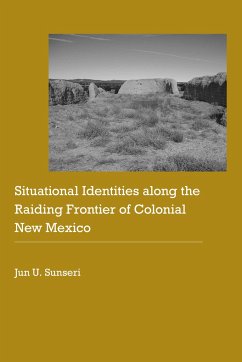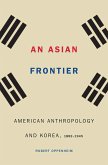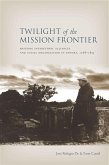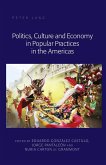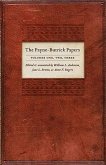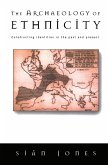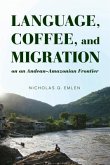Jun U Sunseri
Situational Identities Along the Raiding Frontier of Colonial New Mexico
Jun U Sunseri
Situational Identities Along the Raiding Frontier of Colonial New Mexico
- Gebundenes Buch
- Merkliste
- Auf die Merkliste
- Bewerten Bewerten
- Teilen
- Produkt teilen
- Produkterinnerung
- Produkterinnerung
Jun U.¿Sunseri is an assistant professor of anthropology at the University of California, Berkeley.
Andere Kunden interessierten sich auch für
![An Asian Frontier An Asian Frontier]() Robert OppenheimAn Asian Frontier85,99 €
Robert OppenheimAn Asian Frontier85,99 €![Twilight of the Mission Frontier Twilight of the Mission Frontier]() Jose De La Torre CurielTwilight of the Mission Frontier90,99 €
Jose De La Torre CurielTwilight of the Mission Frontier90,99 €![Politics, Culture and Economy in Popular Practices in the Americas Politics, Culture and Economy in Popular Practices in the Americas]() Politics, Culture and Economy in Popular Practices in the Americas96,85 €
Politics, Culture and Economy in Popular Practices in the Americas96,85 €![The Newspaper Warrior The Newspaper Warrior]() Sarah Winnemucca HopkinsThe Newspaper Warrior85,99 €
Sarah Winnemucca HopkinsThe Newspaper Warrior85,99 €![The Payne-Butrick Papers, Volumes 1, 2, 3 The Payne-Butrick Papers, Volumes 1, 2, 3]() The Payne-Butrick Papers, Volumes 1, 2, 386,99 €
The Payne-Butrick Papers, Volumes 1, 2, 386,99 €![The Archaeology of Ethnicity The Archaeology of Ethnicity]() Siân JonesThe Archaeology of Ethnicity206,99 €
Siân JonesThe Archaeology of Ethnicity206,99 €![Language, Coffee, and Migration on an Andean-Amazonian Frontier Language, Coffee, and Migration on an Andean-Amazonian Frontier]() Nicholas Q EmlenLanguage, Coffee, and Migration on an Andean-Amazonian Frontier75,99 €
Nicholas Q EmlenLanguage, Coffee, and Migration on an Andean-Amazonian Frontier75,99 €-
-
-
Jun U.¿Sunseri is an assistant professor of anthropology at the University of California, Berkeley.
Hinweis: Dieser Artikel kann nur an eine deutsche Lieferadresse ausgeliefert werden.
Hinweis: Dieser Artikel kann nur an eine deutsche Lieferadresse ausgeliefert werden.
Produktdetails
- Produktdetails
- Verlag: Nebraska
- Seitenzahl: 240
- Erscheinungstermin: 1. Februar 2018
- Englisch
- Abmessung: 229mm x 152mm x 18mm
- Gewicht: 508g
- ISBN-13: 9780803296398
- ISBN-10: 0803296398
- Artikelnr.: 48378789
- Herstellerkennzeichnung
- Libri GmbH
- Europaallee 1
- 36244 Bad Hersfeld
- gpsr@libri.de
- Verlag: Nebraska
- Seitenzahl: 240
- Erscheinungstermin: 1. Februar 2018
- Englisch
- Abmessung: 229mm x 152mm x 18mm
- Gewicht: 508g
- ISBN-13: 9780803296398
- ISBN-10: 0803296398
- Artikelnr.: 48378789
- Herstellerkennzeichnung
- Libri GmbH
- Europaallee 1
- 36244 Bad Hersfeld
- gpsr@libri.de
Jun U. Sunseri is an assistant professor of anthropology at the University of California, Berkeley.
List of Figures
List of Tables
Acknowledgements
Chapter 1. Standing Fast in the Middle Ground
Community Research Mandates as a Privilege to Earn for
Historical Archaeology
A Spanish Colonial Project in a Native American Landscape
(Un)documented New Mexico
Previous Archaeological Research
Chapter 2. Digging Out Community
Picturing the Cast(a) of the Drama in Northern New Mexico
Frontline Families and Opportunities
A Turning Point on a Critical Frontier
Viewing Research on the Borderlands from a Distance
Borderlands Identities as Strategy
A Historical Archaeology of Identity as a Complex of Possibilities
Concepts of Homescape and Hearthscape
Chapter 3. Homescape
Landscape and Identity
Maps and Mappings
The Tactical Homescape
The Engineered Homescape
Evaluating Topographic Space for Potential as Agricultural
Place
Modeling Hydrodynamics of Acequia Irrigation
Palimpsests of Place Along the Rito Colorado
Landscape Dimensions in Dialogue
Chapter 4. Hearthscape Tools
Pottery as Foodway Toolkits
Who made these pots?
Typologies and Historic New Mexican Pottery
Choosing Clay for Making Pots
Transformations of Clay into Tools
The Thermodynamic Art of Firing
Pots in Performance
A Process of Identity
Chapter 5. Hearthscape Ingredients
Grazing to Gravy
What Animals Were Part of Life at Casitas?
Creation of the Faunal Archaeological Record
Animal Bodies Becoming Portions
Transformations into Food
Tool Marks and Burning
How was Meat Portioned and Consumed?
Hearthscape Evidence in Dialog
Chapter 6. Historical Archaeology of a Place beyond Labels
Foodways Stages of Production and Consumption
Production Practices Related to Consumption
Use and Disposal
Hearthscape Trends Across the Plazuela
Tactical and Engineering Perspectives on Homescape Practices
Complicating Identity on the Frontier By Putting Scales in
Dialogue
EPILOGUE: Protecting a Guardian of the Frontier
New Directions for Future Research
Archaeology and Preservation as Memory, Performance, and
Political Action
REFERENCES CITED
List of Tables
Acknowledgements
Chapter 1. Standing Fast in the Middle Ground
Community Research Mandates as a Privilege to Earn for
Historical Archaeology
A Spanish Colonial Project in a Native American Landscape
(Un)documented New Mexico
Previous Archaeological Research
Chapter 2. Digging Out Community
Picturing the Cast(a) of the Drama in Northern New Mexico
Frontline Families and Opportunities
A Turning Point on a Critical Frontier
Viewing Research on the Borderlands from a Distance
Borderlands Identities as Strategy
A Historical Archaeology of Identity as a Complex of Possibilities
Concepts of Homescape and Hearthscape
Chapter 3. Homescape
Landscape and Identity
Maps and Mappings
The Tactical Homescape
The Engineered Homescape
Evaluating Topographic Space for Potential as Agricultural
Place
Modeling Hydrodynamics of Acequia Irrigation
Palimpsests of Place Along the Rito Colorado
Landscape Dimensions in Dialogue
Chapter 4. Hearthscape Tools
Pottery as Foodway Toolkits
Who made these pots?
Typologies and Historic New Mexican Pottery
Choosing Clay for Making Pots
Transformations of Clay into Tools
The Thermodynamic Art of Firing
Pots in Performance
A Process of Identity
Chapter 5. Hearthscape Ingredients
Grazing to Gravy
What Animals Were Part of Life at Casitas?
Creation of the Faunal Archaeological Record
Animal Bodies Becoming Portions
Transformations into Food
Tool Marks and Burning
How was Meat Portioned and Consumed?
Hearthscape Evidence in Dialog
Chapter 6. Historical Archaeology of a Place beyond Labels
Foodways Stages of Production and Consumption
Production Practices Related to Consumption
Use and Disposal
Hearthscape Trends Across the Plazuela
Tactical and Engineering Perspectives on Homescape Practices
Complicating Identity on the Frontier By Putting Scales in
Dialogue
EPILOGUE: Protecting a Guardian of the Frontier
New Directions for Future Research
Archaeology and Preservation as Memory, Performance, and
Political Action
REFERENCES CITED
List of Figures
List of Tables
Acknowledgements
Chapter 1. Standing Fast in the Middle Ground
Community Research Mandates as a Privilege to Earn for
Historical Archaeology
A Spanish Colonial Project in a Native American Landscape
(Un)documented New Mexico
Previous Archaeological Research
Chapter 2. Digging Out Community
Picturing the Cast(a) of the Drama in Northern New Mexico
Frontline Families and Opportunities
A Turning Point on a Critical Frontier
Viewing Research on the Borderlands from a Distance
Borderlands Identities as Strategy
A Historical Archaeology of Identity as a Complex of Possibilities
Concepts of Homescape and Hearthscape
Chapter 3. Homescape
Landscape and Identity
Maps and Mappings
The Tactical Homescape
The Engineered Homescape
Evaluating Topographic Space for Potential as Agricultural
Place
Modeling Hydrodynamics of Acequia Irrigation
Palimpsests of Place Along the Rito Colorado
Landscape Dimensions in Dialogue
Chapter 4. Hearthscape Tools
Pottery as Foodway Toolkits
Who made these pots?
Typologies and Historic New Mexican Pottery
Choosing Clay for Making Pots
Transformations of Clay into Tools
The Thermodynamic Art of Firing
Pots in Performance
A Process of Identity
Chapter 5. Hearthscape Ingredients
Grazing to Gravy
What Animals Were Part of Life at Casitas?
Creation of the Faunal Archaeological Record
Animal Bodies Becoming Portions
Transformations into Food
Tool Marks and Burning
How was Meat Portioned and Consumed?
Hearthscape Evidence in Dialog
Chapter 6. Historical Archaeology of a Place beyond Labels
Foodways Stages of Production and Consumption
Production Practices Related to Consumption
Use and Disposal
Hearthscape Trends Across the Plazuela
Tactical and Engineering Perspectives on Homescape Practices
Complicating Identity on the Frontier By Putting Scales in
Dialogue
EPILOGUE: Protecting a Guardian of the Frontier
New Directions for Future Research
Archaeology and Preservation as Memory, Performance, and
Political Action
REFERENCES CITED
List of Tables
Acknowledgements
Chapter 1. Standing Fast in the Middle Ground
Community Research Mandates as a Privilege to Earn for
Historical Archaeology
A Spanish Colonial Project in a Native American Landscape
(Un)documented New Mexico
Previous Archaeological Research
Chapter 2. Digging Out Community
Picturing the Cast(a) of the Drama in Northern New Mexico
Frontline Families and Opportunities
A Turning Point on a Critical Frontier
Viewing Research on the Borderlands from a Distance
Borderlands Identities as Strategy
A Historical Archaeology of Identity as a Complex of Possibilities
Concepts of Homescape and Hearthscape
Chapter 3. Homescape
Landscape and Identity
Maps and Mappings
The Tactical Homescape
The Engineered Homescape
Evaluating Topographic Space for Potential as Agricultural
Place
Modeling Hydrodynamics of Acequia Irrigation
Palimpsests of Place Along the Rito Colorado
Landscape Dimensions in Dialogue
Chapter 4. Hearthscape Tools
Pottery as Foodway Toolkits
Who made these pots?
Typologies and Historic New Mexican Pottery
Choosing Clay for Making Pots
Transformations of Clay into Tools
The Thermodynamic Art of Firing
Pots in Performance
A Process of Identity
Chapter 5. Hearthscape Ingredients
Grazing to Gravy
What Animals Were Part of Life at Casitas?
Creation of the Faunal Archaeological Record
Animal Bodies Becoming Portions
Transformations into Food
Tool Marks and Burning
How was Meat Portioned and Consumed?
Hearthscape Evidence in Dialog
Chapter 6. Historical Archaeology of a Place beyond Labels
Foodways Stages of Production and Consumption
Production Practices Related to Consumption
Use and Disposal
Hearthscape Trends Across the Plazuela
Tactical and Engineering Perspectives on Homescape Practices
Complicating Identity on the Frontier By Putting Scales in
Dialogue
EPILOGUE: Protecting a Guardian of the Frontier
New Directions for Future Research
Archaeology and Preservation as Memory, Performance, and
Political Action
REFERENCES CITED

